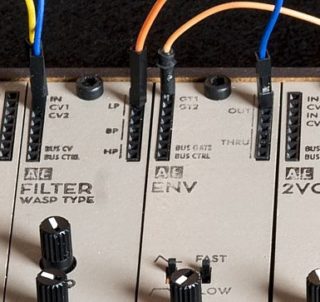Tangible Waves has introduced AE Modular, a new modular synth format designed to be an affordable ‘modular for the masses.
 Much of the cost in most modular synthesizers is in components that do not directly generate sound – custom panels, knobs, jacks, etc. AE Modular eliminates these costs and, as a result, most modules are €20-35:
Much of the cost in most modular synthesizers is in components that do not directly generate sound – custom panels, knobs, jacks, etc. AE Modular eliminates these costs and, as a result, most modules are €20-35:
- Jacks are eliminated, replaced by pin-wires and pin-sockets’
- Knobs are eliminated, you turn pot shaft; and
- Panels are not printed, they’re rubber-stamped with durable ink.
By eliminating some of the most expensive parts of a modular system, Tangible Waves can offer a basic modular system for €328.
The videos, via Felix of The Tuesday Night Machines, offer a quick introduction to the system and some audio examples:
Sound Demo:
Jam Session:
See the Tangible Waves site for more information on the AE Modular.

These look like great buys for the price, but beware the compatibility caveats. Besides the obvious difference (patch cables and module size), there’s a voltage difference.
Eurorack CV signals are -12V to +12V, while these modules use CV in the 0-5V range. If you use the input module they offer to bring in eurorack CV, it limits the signal so it doesn’t break anything, but you’ll have to attenuate incoming signals to not go over 5V or under 0V or they’ll clip.
You wouldn’t need a converter going from the AEModular to eurorack modules, just a cable, but the range of your CV is limited. What that means depends on the module you’re sending CV to… i.e. for a VCO it means a max 5 octave range. For a VCF, depending on how it’s set up, it might mean you can only open the filter not close it (no negative CV).
That said, I’m strongly contemplating buying a few of these. They look like they’ll work great, price is amazing, and if you could set up an “island” of them with just a couple signals in and out you wouldn’t have to worry about the compatibility issues.
Almost everyone that has one of these already, said that the instrument is fairly complete on it’s own and that they treat it like a separate, self-contained synth.
Audio out can, of course be treated however you want.
That said, nothing in Euro is really standard anyway, so you have to mess with levels and voltages pretty carefully to begin with when using multiple manufacturers. The “standard” for Euro is a joke.
I think the 5 volt standard is to make this work well with all the other lab pin synths like Bastl, NS1, maybe the Moog and Arduino stuff.
One thing that’s really cool is that it actually utilizes an internal cv/midi/gate bus that is available at modules that need it. Similar to the Doepfer standard that nobody bothers with.
Eurorack CV standard is 0 – +5v or -5 to +5 (bipolar) . The +/- 12v you’re referring to is supply voltage for the modules.
I’ll just link to one video, but this Youtuber has 20 plus videos using this system, along with lots of other cool gear. Lots of videos of Vermona, boutique effect boxes, plus Treadstone and the other newer AS boxes as well. Tons of great stuff is his uploads.
https://www.youtube.com/watch?v=6wxgD5OHVow
i just think pins are not very durable. it’s still not a cheap machine (yes it’s cheap for a synth but it’s still a lot of lunch money), but i can see problems with trying to travel or play live with pins.
I don’t really see how it should be any less sturdy than the dreaded minijack standard of most eurorack modules.
Those cables only cost cents though. However I’ve had a Tinysizer for many years and never had any issues with the cables and patch sockets. Same with the Bastl bitRanger or Kastle. If you’re rough with them they’d surely break, but not from normal use. Also, on the AE Modular the pins are out of they way of the controls, so you can freely reach and wiggle the knobs, etc. … something which annoys me sometimes with Eurorack. Anyway, so far I haven’t had any concerns when patching my AE system.
I made another video showing how to power the AE Modular system for more than a day with just a small and affordable 9V power bank:
https://www.youtube.com/watch?v=75ViqKUnyxQ